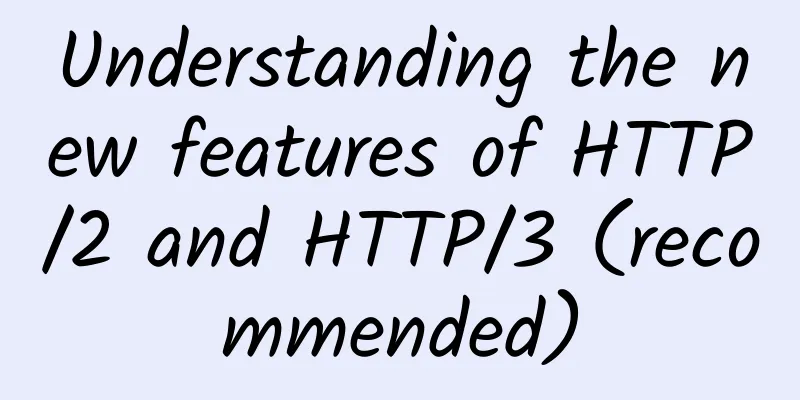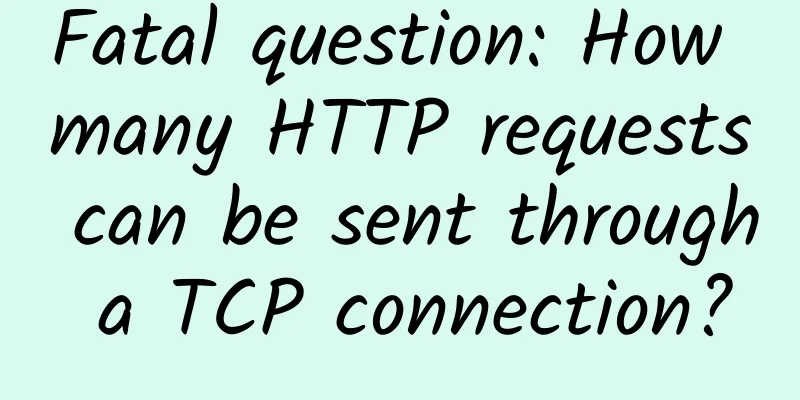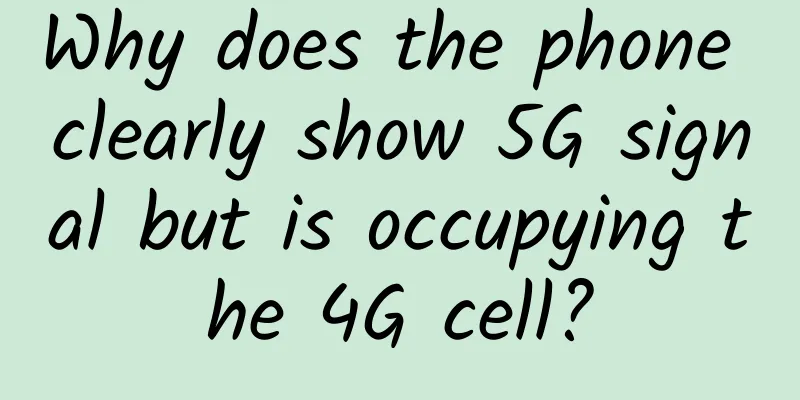Understanding the new features of HTTP/2 and HTTP/3 (recommended)

|
Compared with HTTP/1.1, HTTP/2 can be said to have greatly improved the performance of web pages. Simply upgrading to this protocol can reduce a lot of performance optimization work that needed to be done before. Of course, compatibility issues and how to gracefully degrade should be one of the reasons why it is not widely used in China. Although HTTP/2 improves the performance of web pages, it does not mean that it is perfect. HTTP/3 was introduced to solve some problems existing in HTTP/2. 1. What has changed since the invention of HTTP/1.1? If you look closely at the resources that need to be downloaded to open the homepages of the most popular websites, you will find a very obvious trend. In recent years, the amount of data that needs to be downloaded to load the homepage of a website has gradually increased and has exceeded 2100K. But what we should be more concerned about here is that the average number of resources that need to be downloaded for each page to complete display and rendering has exceeded 100. As shown in the figure below, the size of data transferred and the average number of resources requested have continued to grow since 2011, with no signs of slowing down. The green straight line in the chart shows the growth of the size of data transferred, and the red straight line shows the growth of the average number of resources requested. Since the release of HTTP/1.1 in 1997, we have been using HTTP/1.x for quite a long time. However, with the explosive development of the Internet in the past decade, web pages have changed from being mainly text-based to being mainly rich media (such as pictures, sounds, and videos). In addition, there are more and more applications that require real-time page content (such as chatting and live video streaming). Therefore, some of the features specified in the protocol at that time can no longer meet the needs of modern networks. 2. HTTP/1.1 flaws 1. High latency – resulting in slower page loading speed Although network bandwidth has grown rapidly in recent years, we have not seen a corresponding reduction in network latency. The network latency problem is mainly due to head-of-line blocking, which results in bandwidth not being fully utilized. Head-of-line blocking means that when one request in a sequence of sequentially sent requests is blocked for some reason, all requests queued behind it are also blocked, causing the client to be unable to receive data for a long time. People have tried the following methods to solve head-of-line blocking:
2. Stateless feature - resulting in huge HTTP header Since the message header generally carries many fixed header fields such as "User Agent", "Cookie", "Accept", and "Server" (as shown in the figure below), up to hundreds or even thousands of bytes, but the body is often only tens of bytes (such as GET requests, 204/301/304 responses), it has become a veritable "big-headed son". The content carried in the header is too large, which increases the transmission cost to a certain extent. What's more, many field values in thousands of request and response messages are repeated, which is very wasteful. 3. Plain text transmission-the insecurity it brings When HTTP/1.1 transmits data, all transmitted content is in plain text, and neither the client nor the server can verify the identity of the other party, which to a certain extent cannot guarantee the security of the data. Have you ever heard of news like "free WiFi traps"? Hackers take advantage of the shortcomings of HTTP plain text transmission and set up a WiFi hotspot in a public place to "fish" and trick netizens into going online. Once you connect to this WiFi hotspot, all traffic will be intercepted and saved. If there is sensitive information such as bank card numbers and website passwords in it, it will be dangerous. Hackers can use this data to impersonate you and do whatever they want. 4. Server push messages are not supported 3. Introduction to SPDY Protocol and HTTP/2 1. SPDY protocol As mentioned above, due to the defects of HTTP/1.x, we will introduce sprites, inline small images, use multiple domain names, etc. to improve performance. However, these optimizations bypass the protocol. It was not until 2009 that Google publicly released its self-developed SPDY protocol, which mainly solved the problem of low efficiency of HTTP/1.1. Google's launch of SPDY was considered a formal transformation of the HTTP protocol itself. Reducing latency, compressing headers, etc., the practice of SPDY proved the effectiveness of these optimizations, and eventually led to the birth of HTTP/2. HTTP/1.1 has two major shortcomings: insufficient security and low performance. Due to the huge historical burden of HTTP/1.x, the modification of the protocol and compatibility are the primary considerations, otherwise it will destroy countless existing assets on the Internet. As shown in the figure above, SPDY is located below HTTP and above TCP and SSL, so it can easily be compatible with the old version of the HTTP protocol (encapsulating the content of HTTP1.x into a new frame format) and can use the existing SSL function. After the SPDY protocol was proven to be feasible on the Chrome browser, it was used as the basis for HTTP/2, and its main features were inherited in HTTP/2. 2. Introduction to HTTP/2 In 2015, HTTP/2 was released. HTTP/2 is a replacement for the current HTTP protocol (HTTP/1.x), but it is not a rewrite. The HTTP methods/status codes/semantics are the same as HTTP/1.x. HTTP/2 is based on SPDY and focuses on performance. One of its biggest goals is to use only one connection between the user and the website. From the current situation, some of the top-ranked sites at home and abroad have basically implemented the deployment of HTTP/2. Using HTTP/2 can bring 20%~60% efficiency improvement. HTTP/2 consists of two specifications:
IV. New Features of HTTP/2 1. Binary transfer HTTP/2 significantly reduces the amount of data transmitted, mainly for two reasons: binary transmission and header compression. Let's first introduce binary transmission. HTTP/2 uses binary format to transmit data instead of plain text messages in HTTP/1.x. Binary protocols are more efficient to parse. HTTP/2 splits request and response data into smaller frames, and they are encoded in binary. It moves some features of the TCP protocol to the application layer, breaking up the original "Header+Body" message into several small binary "frames", using "HEADERS" frames to store header data and "DATA" frames to store entity data. After HTP/2 data is framed, the "Header+Body" message structure disappears completely, and the protocol only sees "fragments". In HTTP/2, all communications under the same domain name are completed on a single connection, which can carry any number of bidirectional data streams. Each data stream is sent in the form of a message, which in turn consists of one or more frames. Multiple frames can be sent out of order and can be reassembled based on the stream identifier in the frame header. 2. Header Compression HTTP/2 does not use traditional compression algorithms, but instead developed a special "HPACK" algorithm that establishes a "dictionary" on both the client and server ends, uses index numbers to represent repeated strings, and uses Huffman coding to compress integers and strings, achieving a high compression rate of 50% to 90%. Specifically:
For example, in the following figure, the first request sends all the header fields, while the second request only needs to send the difference data, which can reduce redundant data and reduce overhead. 3. Multiplexing Multiplexing technology is introduced in HTTP/2. Multiplexing solves the problem of browsers limiting the number of requests under the same domain name. It also makes it easier to achieve full-speed transmission. After all, opening a new TCP connection requires slowly increasing the transmission speed. You can use this link to get a visual feel of how much faster HTTP/2 is than HTTP/1. In HTTP/2, with binary framing, HTTP/2 no longer relies on TCP connections to implement multi-stream parallelism. In HTTP/2,
This feature greatly improves performance:
As shown in the figure above, multiplexing technology can transmit all request data through only one TCP connection. 4. Server Push HTTP2 has also changed the traditional "request-response" working mode to a certain extent. The server is no longer completely passive in responding to requests, but can also create a new "stream" to actively send messages to the client. For example, when the browser just requests HTML, the JS and CSS files that may be used are sent to the client in advance to reduce the waiting delay. This is called "Server Push" (also called Cache push). For example, as shown in the figure below, the server actively pushes JS and CSS files to the client without the client sending these requests when parsing HTML. It should also be noted that the server can actively push, and the client also has the right to choose whether to receive. If the resource pushed by the server has been cached by the browser, the browser can reject it by sending a RST_STREAM frame. Active push also complies with the same-origin policy. In other words, the server cannot push third-party resources to the client casually, but must be confirmed by both parties. 5. Improved security For compatibility reasons, HTTP/2 continues the "plain text" feature of HTTP/1. It can use plain text to transmit data as before, and does not force the use of encrypted communication. However, the format is still binary, but it does not require decryption. However, since HTTPS is the general trend, and mainstream browsers such as Chrome and Firefox have publicly announced that they only support encrypted HTTP/2, "in fact" HTTP/2 is encrypted. In other words, the HTTP/2 commonly seen on the Internet uses the "https" protocol name and runs on TLS. The HTTP/2 protocol defines two string identifiers: "h2" for encrypted HTTP/2 and "h2c" for plaintext HTTP/2. 6. HTTP/3 New Features 1. Disadvantages of HTTP/2 Although HTTP/2 solves many problems of previous versions, it still has a huge problem, mainly caused by the underlying TCP protocol. The main disadvantages of HTTP/2 are as follows: (1) TCP and TCP+TLS connection establishment delay HTTP/2 is transmitted using the TCP protocol. If HTTPS is used, the TLS protocol is also required for secure transmission. Using TLS also requires a handshake process, so there are two handshake delay processes:
In short, we need to spend 3 to 4 RTTs before transmitting data. (2) TCP head-of-line blocking has not been completely resolved As mentioned above, in HTTP/2, multiple requests are run in one TCP pipeline. But when packet loss occurs, HTTP/2 performs worse than HTTP/1. Because TCP has a special "packet loss retransmission" mechanism to ensure reliable transmission, lost packets must wait for retransmission confirmation. When HTTP/2 packet loss occurs, the entire TCP must start waiting for retransmission, which will block all requests in the TCP connection (as shown below). For HTTP/1.1, multiple TCP connections can be opened. This situation will only affect one of the connections, and the remaining TCP connections can still transmit data normally. After reading this, some people may wonder why we don’t just modify the TCP protocol? In fact, this is already an impossible task. Because TCP has existed for too long, it has been used in various devices, and this protocol is implemented by the operating system, so it is not realistic to update it. 2. Introduction to HTTP/3 Google was aware of these problems when it was promoting SPDY, so it started a new protocol called "QUIC" based on UDP, allowing HTTP to run on QUIC instead of TCP. This "HTTP over QUIC" is the next major version of the HTTP protocol, HTTP/3. It has achieved a qualitative leap on the basis of HTTP/2, and truly "perfectly" solves the "head of line blocking" problem. Although QUIC is based on UDP, it has added many new features. Next, we will focus on introducing several new QUIC features. However, HTTP/3 is still in the draft stage and may change before its official release, so this article will try not to cover those unstable details. 3. New Features of QUIC As mentioned above, QUIC is based on UDP, which is "connectionless" and does not require "handshakes" or "waves", so it is faster than TCP. In addition, QUIC also implements reliable transmission to ensure that data can reach its destination. It also introduces "streams" and "multiplexing" similar to HTTP/2. A single "stream" is ordered and may be blocked due to packet loss, but other "streams" will not be affected. Specifically, the QUIC protocol has the following characteristics: (1) Implemented flow control and transmission reliability functions similar to TCP. Although UDP does not provide reliable transmission, QUIC adds a layer on top of UDP to ensure reliable data transmission. It provides packet retransmission, congestion control, and other features that exist in TCP. (2) Implemented the fast handshake function. Since QUIC is based on UDP, QUIC can use 0-RTT or 1-RTT to establish a connection, which means that QUIC can send and receive data at the fastest speed, which can greatly improve the speed of opening a page for the first time. 0RTT connection establishment can be said to be the biggest performance advantage of QUIC compared to HTTP2. (3) Integrated TLS encryption function. Currently, QUIC uses TLS1.3, which has more advantages than the earlier version TLS1.3. The most important one is that it reduces the number of RTTs spent on handshakes. (4) Multiplexing completely solves the TCP head-of-line blocking problem Unlike TCP, QUIC implements multiple independent logical data streams on the same physical connection (as shown below). The separate transmission of data streams solves the problem of head-of-line blocking in TCP. VII. Conclusion
|
<<: Java Server Model - TCP Connection/Flow Optimization
>>: Huawei: 5G+AI opens a new era of smart city twins
Recommend
Five steps to modernize your enterprise network
The business value of the network has never been ...
Gartner Releases: Top Ten Wireless Technology Development Trends
Wi-Fi will continue to dominate the industry over...
AlphaVPS: €19.99/year - dual core, 2G memory, 15G SSD hard drive, 1TB monthly traffic, 5 data centers available
AlphaVPS has been shared several times in the blo...
[Black Friday] RAKsmart: VPS flash sale from $0.99/month, cloud server flash sale from $1.99/month, dedicated server flash sale from $30/month
In November, we not only have our Double Eleven S...
The three major operators have removed multiple 4G packages from their shelves. Is the real 5G era coming?
Recently, China Mobile's online business hall...
It’s too early! The conditions for shutting down 2G networks may not be met until 2019
On April 5, while China was going crazy for the &...
How advanced is the "Smart Island" with 20,000 people? Let me help you experience it first!
[51CTO.com original article] On March 21, Huawei ...
Advantages of 5G technology in future US military networks
The article shows that the United States is incre...
Configure HTTPS for React applications running locally
If you build an application with create-react-app...
The number of users is not increasing, the time spent is declining, and 5G applications are delayed. Can we only wait for the flowers to bloom in 2021?
[[397144]] After many twists and turns, the numbe...
5G toB: The next battle between operators and OTT?
In the 5G era, will the battle between operators ...
Yang Xuqing of Softcom Wisdom: Leveraging the advantages of AI and working with Huawei Ascend to promote industry development
As one of Huawei Ascend's important ecologica...
To prevent 5G from the barrel effect, both Sub-6GHz and millimeter wave are indispensable
The wooden barrel effect is a well-known truth. 5...
Communication styles in microservices architecture
In a microservices architecture, communication is...
Casbay: Malaysia VPS monthly payment starts from $9.59, Linux/Windows optional, 100M unlimited traffic
Last month, I shared information about Casbay and...



![[Black Friday] Justhost has a 30% discount for a limited time, 22 data centers in Russia, the United States, Singapore, etc. are available](/upload/images/67cabce3ceaff.webp)

![[Hotspot] ZTE was fined $1 billion but escaped death. Review of the whole ZTE incident](/upload/images/67eba43a68378.webp)
![[2024] What are the VPS in Hong Kong? How to choose a VPS in Hong Kong? Check out the information of VPS merchants in Hong Kong](/upload/images/67cabc6909af9.webp)


